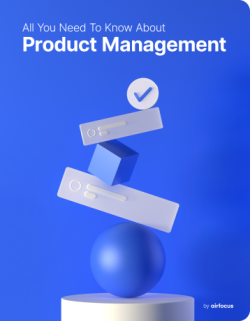
Product managers are often juggling multiple roles. They wear many hats, usually operating at the intersection of several teams. It is a role that isn’t always fully understood, and daily responsibilities can change from one company or project to the next.
In a previous article, we talked about the skills product managers need to succeed. In this article, we will focus on the product manager's responsibilities to answer the question: what exactly is it that product managers actually do?
It isn’t an easy question to answer. Unlike lawyers, for example, the specifics will depend on what a particular product manager specializes in. Still, you can be pretty sure that a corporate contract lawyer will do similar work whether they're in a big firm or a member of an in-house counsel team. Product managers (PMs), on the other hand, don't have those same certainties.
Good product managers are instrumental in the development of a product. Bad product managers, on the other hand, can drag a team and product down with them. Or, as Ben Horowitz points out:
“Good product managers define good products that can be executed with a strong effort. Bad product managers define good products that can't be executed. Good product managers err on the side of clarity vs. explaining the obvious. Bad product managers never explain the obvious.”
Ben Horowitz, Author of The Hard Thing About Hard Things: Building a Business When There Are No Easy Answers
Ultimately, to achieve the company's goals for a product, PMs need to be strong communicators and skilled at managing people and resources. Let’s look at what this means in practice.
7 key product manager responsibilities
#1: Getting products built
Okay, forgive us for this one. It may sound obvious but, first and foremost, you are responsible for getting products built. And not just any old product. Awesome products that customers and users love.
Product development under your management should move the needle. Everything you are doing should improve the user experience and contribute to achieving business goals, whether that is increased revenue, more downloads, or making a product more “sticky.”
Although you aren't necessarily building them yourself, and you don't always need deep technical knowledge, you need to know enough to ask the right questions. This is essential if you want to understand what engineering teams are doing and how they can work more effectively.
In many ways, your product manager responsibilities are to translate business goals into practical development objectives.
Depending on the scale of the company and teams, you could be coordinating with a scrum master or an engineering team lead. They are at the coal face, doing the work. Your role is to support, work with them, and ensure the entire team has the resources to achieve development goals.
At times, this might mean pushing back against business objectives and explaining why something won’t work or why other priorities need to be done before certain features need to be built.
Making sure your development team has a clear order of priority for feature builds and updates is crucial, which is where airfocus can play a valuable role. As a PM, you need to ensure they've got the resources, support, and tech stack in place to build the products the company and customers need.
#2: Ensuring Product-Market Fit
Achieving a product-market fit is an ongoing process and something a product manager should be invested in and spend time working on.
In some companies, you could be working with a product marketing manager. In other cases, you could be working directly with marketing or sales managers. Whichever way your role fits within an organizational chart, the aim of this working dynamic is to make sure that the product is aligned with the needs of sales and marketing.
Features need to appeal to users. The product should be easy to sell, easy to navigate, and clearly solve the pain points users have and give them a compelling reason to buy this product over a competitor’s.
This aspect of your role is communicating sales and marketing needs to development teams. Depending on the priority rating and time-sensitive nature of changes development teams are being asked for, you might need to adjust project priorities and assign resources to new goals. Sometimes you’ll need to push back when priorities change; it is often a balancing act between stakeholders and teams, which is why product managers need to be proactive over-communicators.
#3: Working With Operational Stakeholders
Senior managers and stakeholders need to be kept in the loop. It’s important that they know what the development team is doing, what UX is working on, what bugs QA has encountered, and how everything fits together to achieve business goals and objectives.
Good PMs should maintain a clear and consistent dialogue with the leadership team. At the same time, they should act as a conduit back to engineering and the other teams they work with.
A strong PM should be skilled at getting the resources they need for those teams while also acting as a shield so that engineers aren't receiving mixed and confusing signals from senior leaders.
#4: Aligning Stakeholders
Which brings us nicely onto the next point…
….making sure everyone is on the same page is a crucial part of this role. We simply cannot overstate that enough.
Expectations should be managed.
Every team you are working with and responsible for should be aligned.
A breakdown in communication or one team working on one goal and another on something different can cause chaos. Mis-aligned teams, objectives, and resources can easily result in product development setbacks, unhappy senior managers or engineers, and ultimately, customers that don't get the experience they need.
As a rule, product managers should have workflows and processes for managing the various and multi-layered lines of communication they need to maintain. This is why clear roadmaps make the work of PMs easier and more efficient.
Over-communicating is always preferable to making assumptions or not explaining why certain decisions are needed. Good product managers know this intuitively.
#5: Quality Assurance
Working with a QA and/or product testing team is another important part of a product manager’s job.
Before products can go live, or feature updates made, a QA team needs to test and debug them. After an update or product goes live, feedback will flow in from users and customers.
As a product manager, you then need to assign debugging or other improvements into the engineering workflow. In some cases, debugging is the work of a few minutes or hours and is easily prioritized. In other cases, tasks need to be reassigned, prioritize moved around to ensure changes can be made that will keep users and customers happy.
Remember, it’s not just about building products, but about building awesome products that “stick”.
#6: User Experience and Testing
Another team you need to work with are those responsible for user experience and user testing (UX). This might be referred to as Product Discovery in some companies.
UX processes will center around how users actually experience products. It will involve interviewing and observing users and taking this data back to engineering teams to implement improvements.
While you may not be directly involved in this user-focused role, you’ll be closely involved in it. It’ll be your job to determine how to prioritize features and updates according to a constant discovery pipeline, using lean or agile practices (the build - measure - learn feedback loop).
#7: Dive In And Get Stuff Done
In this role, there is an emphasis on communication and managing. So the ability to dive in when all hands are needed on deck will demonstrate that you can roll your sleeves up.
Working as a product manager is interesting and challenging. No two days are the same. No two product managers will experience the work in the same way. There is always going to be something of a variety of responsibilities, depending on the company, teams, and products.
Above all, communication is an essential part of the role.
Explaining, clearly articulating, and in many cases, translating the needs of one group of stakeholders to another is an essential part of the role.
Great products rely on exceptional product managers — you guys are central to the product development process, both at a strategic and practical level. With the right emphasis on skills that are needed for this role, you’ll be well on your way to building killer products that users love.
Which leaves just one question remaining: which world-changing products will you build next?
So what are the product manager's responsibilities?
A product manager has to get products built, ensure product-market fit, work with operational stakeholders, align stakeholders, quality assurance, user experience, and testing, and get stuff done.
Would you add anything to this list? Let us know on Twitter!
Valentin Firak

Read also

Experience the new way of doing product management

Experience the new way of doing product management







